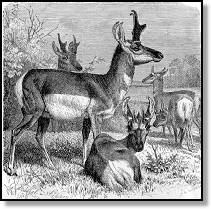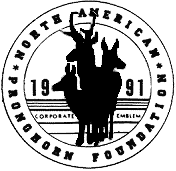



The pronghorn is the rocket of the American West and unique in all the world. It is the fastest animal in North America and the second-fastest land mammal on earth, exceeded only by the African cheetah. And for distances over a quarter-mile, the pronghorn would win over every other animal on earth. These remarkable creatures can reach speeds of 70 mph; one source reports 84 mph. It's no wonder that Captain William Clark remarked upon first seeing pronghorns in 1804 that their motion was so fast, it was like "the rapid flight of birds."
Unlike most animal speedsters, the pronghorn isn't built merely for short bursts. This racer is built to keep going, and going...and going. While cheetahs are winded after a quarter-mile, a pronghorn can maintain a 60 mph pace for three or four minutes. And it can comfortably cruise at 30 mph for up to five miles before slowing. Even young pronghorns just a few hours old can, if necessary, run up to 45 mph.
Millions of years ago, the pronghorn developed speed to escape fierce Pleistocene predators like the dire wolf and prehistoric cheetah. But reports of pronghorns racing horsemen and even automobiles seem to suggest that maybe the pronghorn also races just for the sheer joy of it.
What makes the turbocharged pronghorn capable of such speed? Oxygen-and the special ability to process lots of it. Pronghorns consume three times the oxygen of similarly-sized animals. An oversized trachea or windpipe, huge lungs, and a large heart give the pronghorn the ability to consume large amounts of oxygen. Even pronghorn muscle cells are packed with mitochondria, allowing them to burn more oxygen. Pronghorns also run with their mouths open-not because they are tired, as many assume, but because it allows the animals to take in more air. In addition, pronghorn hooves are padded to minimize shock, and their leg bones are extremely powerful.
Pronghorns are an ancient species dating back nearly 20 million years-the only survivor of a group of hoofed mammals that originated in North America, and one of the few living links with the Ice Age. Pronghorns successfully survived the late Cenozoic and Pleistocene eras, as well as massive changes 11,000 years ago when a mysterious mass extinction claimed many other species. Indeed, the pronghorn was here to greet the first humans who set foot in North America, and ancestral Native Americans hunted pronghorn as much as 30,000 years ago.
The pronghorn may have endured in part because it's tough. If necessary a pronghorn can go days without water, and will eat and thrive on plants no other grazing animal will touch-even thorny cactus. Pronghorns successfully survive both bitter cold and desert heat equally well.
No other creature in the world is related to the pronghorn. The pronghorn's namesake-its distinctive horns-is the hallmark that gives the pronghorn its own genus, because it's the only animal in the world to annually shed a branched horn.
Using their distinctive white rump patches, pronghorns have a very unusual but effective method of warning others in the herd. Special muscles allow the pronghorn to flare its white rump hairs, instantly signaling a danger message to the entire herd. Even fawns just a few days old can signal other pronghorns by flashing their white rump patches.
The name "antelope" comes from the Greek antholops, meaning "brightness of the eye." Perhaps this curious name is appropriate. Pronghorn eyes are protruding, exceptionally large relative to the animal's size, and set high on either side of their head. These unusual eyes give pronghorns extraordinary vision and the ability to better detect the presence of distant predators three or four miles away.
Although nearly everyone is aware of the buffalo's vast numbers in pre-settlement times, few realize that pronghorns equalled and perhaps even exceeded the bison. Immense pronghorn herds-an estimated 40 million; some say as many as 70 million-mingled with untold numbers of bison and deer, filling the American West from the shortgrass prairies of the western Great Plains, to Southwestern deserts, to the midgrass of eastern Nebraska. As late as the 1870s, a train passenger described a herd of pronghorns that stretched for seventy miles, containing an estimated one million animals. At the time when Lewis and Clark made their way to the Pacific, the pronghorn's range was enormous, stretching west of the Mississippi River to California, north to Manitoba, and south nearly all the way to Mexico City.
In Pronghorn: Portrait of an American Antelope, Gary Turbak recounts a Blackfeet legend that tells how the pronghorn came to live on the prairie. The Blackfeet god called Old Man created the antelope on the slopes of the Rockies, but when he turned the animal loose, its great speed caused it to stumble and fall on the rocks and fallen timber of the mountains. So Old Man moved the pronghorn to the prairie, where it was content.
And so it was that, along with the bison, the pronghorn ruled the plains. For eons these twin monarchs coexisted with each other in a mutually beneficial relationship. While bison preferred prairie grasses, pronghorn ate the broad-leafed plants or forbs, sagebrush, and shrubs. Grazing by bison allowed the remaining forbs to grow and develop. So pronghorn moved in the wake of the buffalo, eating the flourishing forbs that were left behind. Over the centuries legions of pronghorn trailed immense herds of bison, season after season, year after year, in one of the prairie's great natural cycles.
Native Americans had many names for the pronghorn. The Cree called pronghorn "small caribou;" the Yankton Sioux named it "small deer." To the Ogallala Sioux, pronghorn were "pale deer." But for a long time Europeans didn't know what to make of this strange animal, usually describing it as a kind of goat. The Spanish explorer Coronado and his party-very likely the first Europeans to see the pronghorn-toured the southwestern Great Plains about 1540, roaming as far north as Kansas in search of gold. The group's official recorder noted large herds of 'goats' in "flocks of more than a hundred together, which ran so fast that they disappeared very quickly." Coronado himself noted in his journal, "There is a great abundance of wild goats the color of bay horses."
Lewis and Clark first came upon the pronghorn near present-day Nebraska and South Dakota. "Such an animal," recorded his assistant, Sergeant John Ordway, "was never yet known in the [United] States." Captain Meriwether Lewis reported that "the agility and superior fleetness of this animal...was to me really astonishing....I think I can safely venture the assertion that the speed of this animal is equal, if not superior, to that of the finest blooded courser."
But after Lewis and Clark came the settlers-and with the settlers came the great slaughter. Like the bison, millions of antelope fell before market hunters. Huge piles of meat-tons upon tons of meat-filled trainload after trainload bound for the East and West coasts. Even when people couldn't eat all the meat, pronghorns were still slaughtered. So many pronghorns were killed that the sheer quantity of meat glutted the market, making it almost worthless. In Denver during the 1860s, just twenty-five cents could buy three or four entire pronghorn carcasses-a single coin for hundreds of pounds of meat. Sometimes hunters couldn't even give the meat away. Despite this, pronghorns continued to be routinely shot by the hundreds or even thousands and the carcasses simply left on the prairie to rot.
Ranchers and farmers also killed pronghorn, erroneously believing the antelope would take away forage from sheep or cattle. And that peculiarly human wildlife destroyer-development-further decimated pronghorn herds as farms, ranches, and towns were built. Farmers turned native prairie into cultivated fields, eliminating the prairie plants antelope had lived on for millennia. Fencing the land also devastated the pronghorn, because while the animals are fleet of foot, oddly enough they can't jump. Even today, just four feet of mesh fencing is enough to keep migrating herds from getting to crucial feeding habitat, condemning them to death by slow starvation as they mass up helplessly against the wire.
Over eons the pronghorn had survived massive continental changes and nature's ruthless winnowing out of their less-adaptive cousins. Not only had they survived, they had flourished. They had adapted and thrived on harsh climates and harsh diets in nearly every part of the American West. But the pronghorn was no match for ignorance, greed, blood lust, and the loaded gun. Within just a few decades, hunters, farmers, and ranchers virtually wiped out a species that had been a part of the North American continent for nearly 20 million years.
By the early 1900s the pronghorn had vanished from most of the West. Only 1,000 pronghorns were left in Colorado out of the original one million antelope that once ran wild within the state. In all of North America, a handful of just 10,000 remained-sole survivors of once-mighty herds that only fifty years earlier had numbered in the tens of millions.
Beginning in the 1920s, concerted efforts helped bring the pronghorn back from extinction. Grazing controls for domestic stock, strict law enforcement against illegal hunting, and intensive livetrapping and transplanting have increased the statewide population to over 60,000 animals, or three percent of historic numbers. There are now an estimated one million pronghorns in North America. Although the current population is just a fraction of its former strength, nevertheless the pronghorn recovery is considered today by many to be one of the our nation's wildlife success stories. Perhaps the real success factor in this story is the hard work, determination, and dedicated funding over the last 75 years to keep the pronghorn from disappearing from the earth forever.
Although ironically it was sportsmen's hunting license fees that were largely responsible for funding the pronghorn recovery effort, the bitter taste of the massive hunting slaughter in the last century lingers in some circles. Today, about 10,000 pronghorns are killed annually by hunters in Colorado, but wildlife managers consider this number to be at sustainable levels.
Even so, as Gary Turbak relates, an Apache folktale suggests the pronghorn should never be hunted. Long ago, explains the legend, a beautiful young woman of the tribe became a pronghorn antelope herself. Even today her descendants still run with the wild herds, racing across the prairie. Perhaps in spirit at least, the pronghorn are really our brethren.
North American Pronghorn Foundation Reprint
By Permission of Author
1999
By Lisa Hutchins
March 1999
Prairie Racer: The Pronghorn Antelope

 | ||||
North American Pronghorn Foundation
© 1991-2009 North American Pronghorn Foundation
 | ||||
 | ||||||
NORTH AMERICAN PRONGHORN FOUNDATION
P.O. Box 1383
Rawlins, Wyoming 82301

 | ||||||
